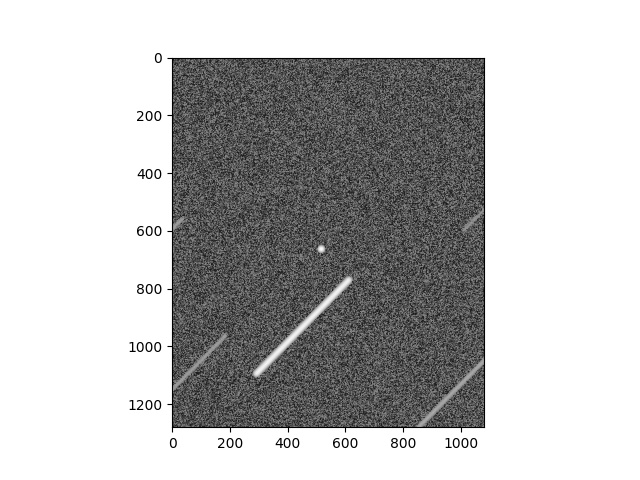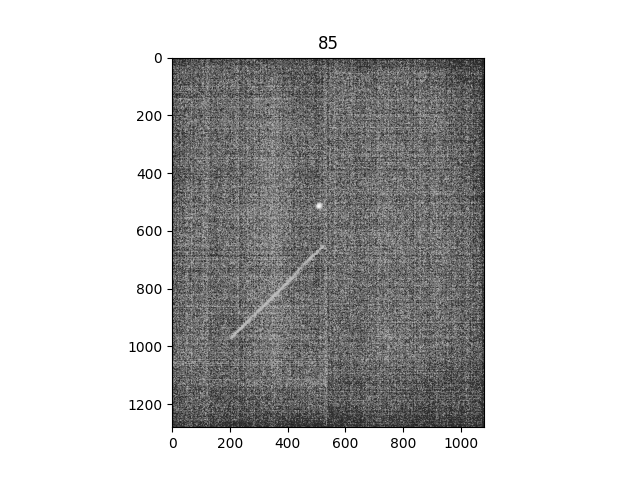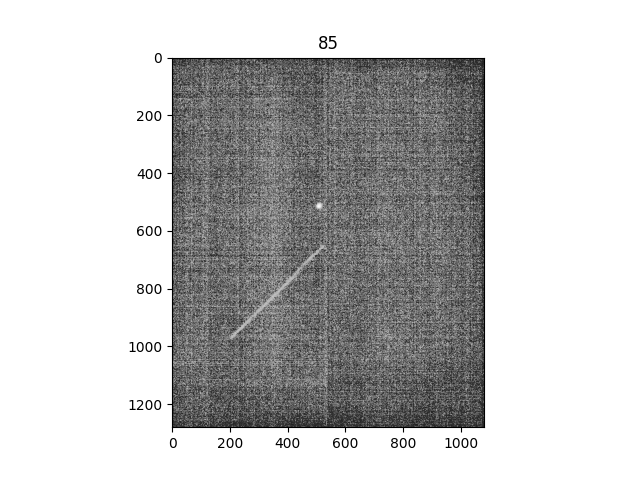Note
Go to the end to download the full example code.
Zimmerwald Data#
Generating a synthetic image to compare with one taken by the Zimmerwald MAIN telescope
/Users/liamrobinson/Documents/maintained-research/mirage/mirage/orbit.py:504: UserWarning: Velocity is transformation is missing omega cross r term from TEME to J2000, but this is tiny
warnings.warn(
RA tracking rate: -241.745 arcsec/sec, Dec tracking rate: 422.568 arcsec/sec
71.92084429254598
-133.07915570745402
[ 0.70734835 -0.5132297 0.48605923]
Object identity: 2013-021D
Observation midpoint: 2022-08-31 22:45:57.612325+00:00 UTC
Exposure time: 0.5 seconds
We are looking at RA/Dec (midpoint): (array([122.]), array([40.]), array([10.89643493])), (array([59.]), array([9.]), array([11.33693735]))
[-0.27677729 0.43162696 0.85854091]
[-0.00804722 0.89237167 -0.45122947]
1851.2652170837423
[[2.13045823]]
6.324055866080483e+16
2.083072572809811e-12
65867.33661774624
Objects in frame 1:
AVUM DEB (ADAPTOR)
Synthesizing CCD Image: 1.48e+00 seconds
Background std of synthetic image: 2.93
Background std of real image: 1.95
Objects in frame 1:
AVUM DEB (ADAPTOR)
import datetime
import os
import matplotlib.pyplot as plt
import numpy as np
from scipy.interpolate import RegularGridInterpolator
import mirage as mr
import mirage.photo as mrp
file = '/Users/liamrobinson/Library/CloudStorage/OneDrive-purdue.edu/aiub/ZigZag/13021D_31082022_fullframe.fits'
header, data = mrp.load_fits(file)
intl_des = '2013-021D'
cycle_time = header['ACT']
i = 85
img = data[i].T # Transpose to get its dimensions right
timedelta_to_i = mr.seconds(i * cycle_time)
date_obs_initial = (
datetime.datetime.strptime(header['FRAME'], '%Y-%m-%dT%H:%M:%S.%f').replace(
tzinfo=datetime.timezone.utc
)
+ timedelta_to_i
)
integration_time_s = header['EXPOSURE']
date_mid = date_obs_initial + mr.seconds(integration_time_s / 2)
obj = mr.SpaceObject('cube.obj', identifier=intl_des)
station = mr.Station('zimmain')
station.telescope.fwhm = 4
catalog = mr.GaiaSpectralStarCatalog(station)
obj_pos, obj_vel = obj.propagate(date_mid, return_velocity=True)
station_pos, station_vel = station.j2000_at_dates(date_mid, return_velocity=True)
r_obs = mr.vecnorm(obj_pos - station_pos)[0]
look_dir_eci = mr.hat(obj_pos - station_pos)
up_dir_eci = mr.hat(station_pos) # for the az/el mount
az, el = station.eci_to_az_el(date_mid, look_dir_eci)
theta = 90 - np.rad2deg(el)
dra, ddec = mr.rv_to_daz_del(obj_pos - station_pos, obj_vel - station_vel)
dra *= mr.AstroConstants.rad_to_arcsecond
ddec *= mr.AstroConstants.rad_to_arcsecond
print(
f'RA tracking rate: {dra:.3f} arcsec/sec, Dec tracking rate: {ddec:.3f} arcsec/sec'
)
v_perp = mr.hat(np.cross(look_dir_eci, up_dir_eci))
up_dir_eci = np.cross(v_perp, look_dir_eci)
print(theta)
rotator_angle = np.deg2rad(theta - 205)
print(np.rad2deg(rotator_angle))
print(up_dir_eci)
up_dir_eci = mr.rv_to_dcm(look_dir_eci * rotator_angle) @ up_dir_eci
look_ra_app, look_dec_app = mr.eci_to_ra_dec(look_dir_eci)
print(f'Object identity: {intl_des}')
print(f'Observation midpoint: {date_mid} UTC')
print(f'Exposure time: {integration_time_s} seconds')
print(
f'We are looking at RA/Dec (midpoint): {mr.rad_to_dms(look_ra_app)}, {mr.rad_to_dms(look_dec_app)}'
)
print(look_dir_eci)
print(up_dir_eci)
# import pyvista as pv
# import mirage.vis as mrv
# p = pv.Plotter()
# mrv.render_observation_scenario(
# p,
# np.array([date_mid]),
# station=station,
# look_dirs_eci=look_dir_eci,
# sensor_extent_km=r_obs,
# up_dirs_eci=up_dir_eci,
# )
# p.show()
phase_angle_rad = mr.angle_between_vecs(-look_dir_eci, mr.sun(date_mid))
s2 = mr.Station()
sint_val = mr.sint(s2, np.deg2rad(theta))[0]
print(r_obs)
print(phase_angle_rad)
print(sint_val)
r_sph_meter = 1
irrad_sphere = (
mr.AstroConstants.sun_irradiance_vacuum
* mr.normalized_light_curve_sphere(
cd_sphere=0.5, r_sphere_m=r_sph_meter, phase_angle_rad=phase_angle_rad
)
/ (r_obs * 1e3) ** 2
)[0, 0]
print(irrad_sphere)
obj_signal = sint_val * irrad_sphere * integration_time_s
print(obj_signal)
# endd
mr.tic('Synthesizing CCD Image')
img_syn = station.telescope.ccd.generate_ccd_image(
date_mid,
integration_time_s,
station,
look_dir_eci,
[dra, ddec],
obj_signal,
catalog,
up_dir_eci=up_dir_eci,
add_distortion=False,
noise=True,
sky_brightness=True,
binning=(2, 2),
)
flat_frame = np.load(os.path.join(os.environ['DATADIR'], 'zimmain_flat.nogit.npy'))
mr.toc()
# simulating binning
assert all(
[not x % 2 for x in img_syn.shape]
), "One or more of the image's dimensions sizes is odd, cannot bin"
img_syn = img_syn.reshape(img_syn.shape[0] // 2, 2, img_syn.shape[1] // 2, 2).sum(
axis=(1, 3)
)
img_syn, _, _, img_syn_br_std = mrp.background_subtract(
img_syn,
reduction_factor=1,
sigma=3.0,
box_size=100,
)
img, _, _, img_br_std = mrp.background_subtract(
img, reduction_factor=1, sigma=3.0, box_size=100
)
print(f'Background std of synthetic image: {img_syn_br_std:.2f}')
print(f'Background std of real image: {img_br_std:.2f}')
np.savez(
'/Users/liamrobinson/Documents/maintained-research/mirage/examples/14-digital-twin-2024/data/zim.nogit.npz',
img=img,
img_syn=img_syn,
br_std_img=img_br_std,
br_std_synth=img_syn_br_std,
)
plt.figure()
mrp.plot_fits(img_syn)
plt.figure()
mrp.plot_fits(img)
plt.title(f'{i}')
plt.show()
r_sph_meter = 3
irrad_sphere = (
mr.AstroConstants.sun_irradiance_vacuum
* mr.normalized_light_curve_sphere(
cd_sphere=1, r_sphere_m=r_sph_meter, phase_angle_rad=phase_angle_rad
)
/ (r_obs * 1e3) ** 2
)[0, 0]
obj_signal = sint_val * irrad_sphere * integration_time_s
flat_frame_interp = RegularGridInterpolator(
points=(np.arange(0, 2160, 2), np.arange(0, 2560, 2)),
values=flat_frame,
bounds_error=False,
fill_value=1.0,
)
mr.tic('Synthesizing CCD Image')
img_syn = station.telescope.ccd.generate_ccd_image(
date_mid,
integration_time_s,
station,
look_dir_eci,
[dra, ddec],
obj_signal,
catalog,
up_dir_eci=up_dir_eci,
add_distortion=False,
noise=True,
sky_brightness=True,
binning=(2, 2),
flat_field=None,
)
img_syn = img_syn.reshape(img_syn.shape[0] // 2, 2, img_syn.shape[1] // 2, 2).sum(
axis=(1, 3)
)
img_syn, _, _, img_syn_br_std = mrp.background_subtract(
img_syn,
reduction_factor=1,
sigma=3.0,
box_size=100,
)
img_syn = img_syn.astype(np.float32)
img_syn = img_syn * 0.002 + 100 # Attenuating for clouds
img_syn = img_syn * flat_frame.T # Apply the flat fielding effect
# Subtract the background again
img_syn, _, _, img_syn_br_std = mrp.background_subtract(
img_syn,
reduction_factor=1,
sigma=3.0,
box_size=100,
)
np.savez(
'/Users/liamrobinson/Documents/maintained-research/mirage/examples/14-digital-twin-2024/data/zim_corr.nogit.npz',
img=img,
img_syn=img_syn,
br_std_img=img_br_std,
br_std_synth=img_syn_br_std,
)
plt.figure()
mrp.plot_fits(img_syn)
plt.figure()
mrp.plot_fits(img)
plt.title(f'{i}')
plt.show()
Total running time of the script: (0 minutes 11.784 seconds)




